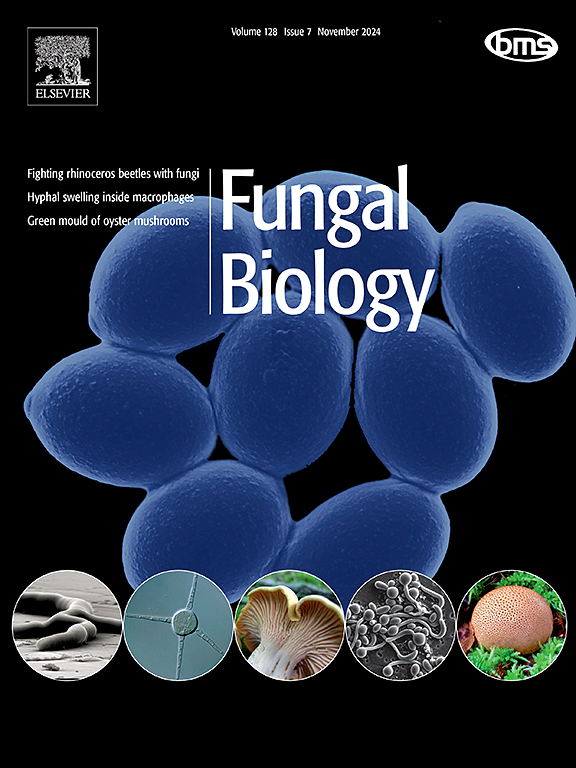具有抗真菌代谢物的真菌内生菌在温室试验中减轻了黄曲霉白蜡枯梢病的症状
IF 3
3区 生物学
Q2 MYCOLOGY
引用次数: 0
摘要
欧洲白蜡树(Fraxinus excelsior)受到外来真菌Hymenoscyphus fraxineus的威胁,造成树冠枯死和根颈坏死。真菌内生菌可以在无症状的情况下自然定植树木,并能产生生物活性代谢物,利用真菌内生菌可能提供机会作为生物防治剂,以减少黄萎病的症状发展。本研究选取了符合上述标准的4个属的分离株,并选择了6个有希望进行温室实验的分离株:Diaporthe oncostoma (DSM 116298)、Pezicula abietina (DSM 5141)、Pezicula cferae (DSM 110620)、Nemania diffusa (DSM 116299)、perforatum Hypoxylon (MUCL 54174)和rubiginosum Hypoxylon (DSM 106870)。利用核磁共振(NMR)和高分辨率质谱(HRMS)数据对次生代谢组进行了详细分析,确定了这些内生菌的代谢物:abietina产生的菌根素A, p.c.c erae产生的cj - 17572, hyph . rubiginosum产生的phomopsidin和N. diffusa产生的细胞chalasin E是主要的抗真菌药物。除了检测到多种潜在的细胞松弛素外,还从肿瘤肿瘤中分离到了新的化合物9-外延木内酯A。通过温室试验研究了内生菌是否能减轻植物白蜡树枯梢病的症状。当两岁的黄芪树苗单独人工接种六种内生菌时,没有出现明显的疾病症状。对于六种内生菌中的两种,我们观察到,与只接种病原菌的树苗相比,随后接种低毒力的黄曲霉菌株的树苗明显减少了坏死病变的发展。将6种候选生物防治剂与1株毒力较高的拉克希纽斯菌株联合使用时,病变发展最初受到抑制,但抑制作用并不显著,并且在监测期间以不同的速率下降。与单独接种任一菌株的树苗相比,双接种树苗的死亡延迟。这些结果表明,内生菌可以减少与感染相关的症状和死亡率。本文章由计算机程序翻译,如有差异,请以英文原文为准。
Fungal endophytes with anti-fungal metabolites reduce symptoms of ash dieback in Fraxinus excelsior in a greenhouse experiment
European ash trees (Fraxinus excelsior) are threatened by the non-native fungal pathogen Hymenoscyphus fraxineus, which causes crown dieback and root collar necroses. The exploitation of fungal endophytes, which naturally colonise trees asymptomatically and can produce bioactive metabolites, may provide opportunities as biocontrol agents to reduce symptom development in F. excelsior. We focused our investigations on isolates of four genera which fulfil these criteria and selected six promising candidates for greenhouse experiments: Diaporthe oncostoma (DSM 116298), Pezicula abietina (DSM 5141), Pezicula cf. ericae (DSM 110620), Nemania diffusa (DSM 116299), Hypoxylon perforatum (MUCL 54174) and Hypoxylon rubiginosum (DSM 106870). A detailed analysis of the secondary metabolomes by NMR (nuclear magnetic resonance) and HRMS (high resolution mass spectrometry) data identified known metabolites from these endophytes: mycorrhizin A produced by P. abietina, CJ-17,572 from P. cf. ericae, phomopsidin from Hyp. rubiginosum and cytochalasin E from N. diffusa as key anti-fungal agents. Besides detecting multiple potential cytochalasins, the new compound 9-epi-xylaolide A was isolated from D. oncostoma.
A greenhouse experiment was conducted to determine whether the endophytes could reduce symptoms of ash dieback in planta. When two-year old F. excelsior saplings were artificially-inoculated with each of the six endophytes alone, no significant symptoms of disease developed. For two of the six endophytes, we observed significantly reduced necrotic lesion development when saplings were subsequently inoculated with a H. fraxineus strain of low virulence, compared to saplings inoculated only with the pathogen. In combinations of the six biocontrol candidates and a H. fraxineus strain of higher virulence, lesion development was initially inhibited, however inhibition was not significant and decreased at different rates over the monitoring period. Mortality was delayed in dual-inoculated saplings compared to saplings inoculated with either of the H. fraxineus strains alone. These results indicate symptoms and mortality associated with H. fraxineus infection can be reduced by endophytes.
求助全文
通过发布文献求助,成功后即可免费获取论文全文。
去求助
来源期刊

Fungal biology
MYCOLOGY-
CiteScore
5.80
自引率
4.00%
发文量
80
审稿时长
49 days
期刊介绍:
Fungal Biology publishes original contributions in all fields of basic and applied research involving fungi and fungus-like organisms (including oomycetes and slime moulds). Areas of investigation include biodeterioration, biotechnology, cell and developmental biology, ecology, evolution, genetics, geomycology, medical mycology, mutualistic interactions (including lichens and mycorrhizas), physiology, plant pathology, secondary metabolites, and taxonomy and systematics. Submissions on experimental methods are also welcomed. Priority is given to contributions likely to be of interest to a wide international audience.
 求助内容:
求助内容: 应助结果提醒方式:
应助结果提醒方式:


